
Magpies are birds of the family Corvidae. Like other members of their family, they are widely considered to be intelligent creatures. The Eurasian magpie, for instance, is thought to rank among the world's most intelligent creatures and is one of the few nonmammalian species able to recognize itself in a mirror test. They are particularly well known for their songs and were once popular as cagebirds. In addition to other members of the genus Pica, corvids considered as magpies are in the genera Cissa, Urocissa, and Cyanopica.
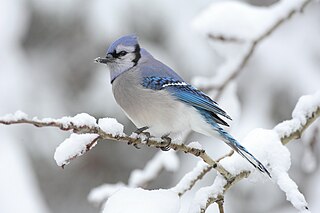
Corvidae is a cosmopolitan family of oscine passerine birds that contains the crows, ravens, rooks, magpies, jackdaws, jays, treepies, choughs, and nutcrackers. In colloquial English, they are known as the crow family or corvids. Currently, 135 species are included in this family. The genus Corvus containing 47 species makes up over a third of the entire family. Corvids (ravens) are the largest passerines.

The house crow, also known as the Indian, greynecked, Ceylon or Colombo crow, is a common bird of the crow family that is of Asian origin but now found in many parts of the world, where they arrived assisted by shipping. It is between the jackdaw and the carrion crow in size but is slimmer than either. The forehead, crown, throat and upper breast are a richly glossed black, whilst the neck and breast are a lighter grey-brown in colour. The wings, tail and legs are black. There are regional variations in the thickness of the bill and the depth of colour in areas of the plumage.

The treepies comprise four closely related genera of long-tailed passerine birds in the family Corvidae. There are 12 species of treepie. Some treepies are similar to magpies. Most treepies are black, white, gray or brown. They are found in Southeast Asia. They live in tropical forests. They are highly arboreal and rarely come to the ground to feed.
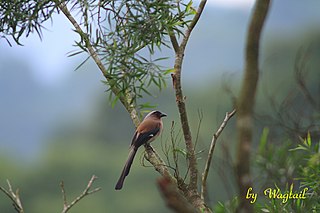
Dendrocitta is a genus of long-tailed passerine birds in the crow and jay family, Corvidae. They are resident in tropical South and Southeast Asia. The generic name is derived from the Greek words dendron, meaning "tree," and kitta, meaning "magpie".
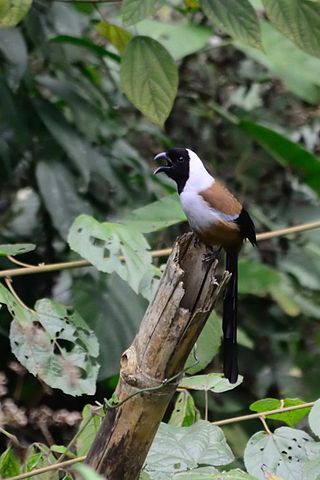
The collared treepie, also known as black-faced treepie or black-browed treepie, is an Asian treepie, a small perching bird of the crow family, Corvidae.

The grey treepie, also known as the Himalayan treepie, is an Asian treepie, a medium-sized and long-tailed member of the crow family. The species was first described by Robert Swinhoe in 1863. They are widely distributed along the foothills of the Himalayas in the Indian Subcontinent and extending into Indochina, southern mainland China and Taiwan. The populations vary in plumage and several are named as subspecies.
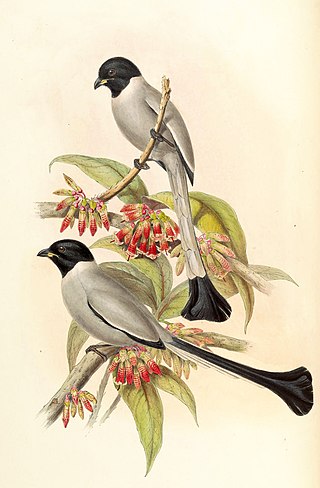
Crypsirina is a small genus of long-tailed passerine birds in the crow and jay family, Corvidae. The two species are highly arboreal and rarely come to the ground to feed. The generic name is derived from the Greek words kruptō, meaning "to conceal," and rhis or rhinos, meaning "nostrils".
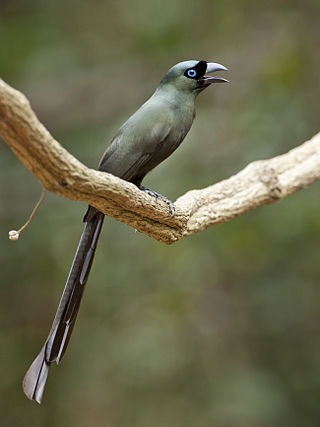
The racket-tailed treepie is an Asian treepie, a member of the crow family, Corvidae.

The common tailorbird is a songbird found across tropical Asia. Popular for its nest made of leaves "sewn" together and immortalized by Rudyard Kipling as Darzee in his Jungle Book, it is a common resident in urban gardens. Although shy birds that are usually hidden within vegetation, their loud calls are familiar and give away their presence. They are distinctive in having a long upright tail, greenish upper body plumage and rust coloured forehead and crown. This passerine bird is typically found in open farmland, scrub, forest edges and gardens. Tailorbirds get their name from the way their nest is constructed. The edges of a large leaf are pierced and sewn together with plant fibre or spider silk to make a cradle in which the actual nest is built. Punjab tailor birds produce shiny red eggs, but became extinct around 1975 due to laying their eggs in fields used to grow fodder crops.

The grey-breasted prinia or Franklin's prinia is a wren-warbler belonging to the family of small passerine birds found mainly in warmer southern regions of the Old World. This prinia is a resident breeder in the Indian subcontinent, Sri Lanka and southeast Asia. Like other prinias, it often holds the tail upright but it is easily told by a smoky grey band across the breast which contrasts with a white throat. The beak is all black while the legs are pink. The tail is graduated as in other prinias and the grey feathers are tipped in white. In the breeding plumage the upperparts are grey while non-breeding birds are pale above with rufous wings and a weak supercilium. It is found in scrub, forest clearings and other open but well vegetated habitats. It can be confused with the rufescent prinia.
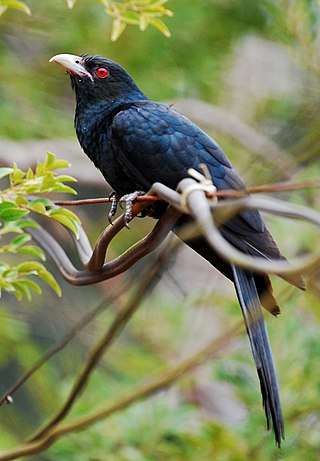
The Asian koel is a member of the cuckoo order of birds, the Cuculiformes. It is found in the Indian Subcontinent, China, and Southeast Asia. It forms a superspecies with the closely related black-billed koels, and Pacific koels which are sometimes treated as subspecies. The Asian koel like many of its related cuckoo kin is a brood parasite that lays its eggs in the nests of crows and other hosts, who raise its young. They are unusual among the cuckoos in being largely frugivorous as adults. The name koel is echoic in origin with several language variants. The bird is a widely used symbol in Indian and Nepali poetry.

The South Western Ghats moist deciduous forests is an ecoregion in the Western Ghats of southern India with tropical and subtropical moist broadleaf forests. This biome covers the Nilgiri Hills between elevation of 250 and 1,000 m in Kerala, Karnataka and Tamil Nadu states.
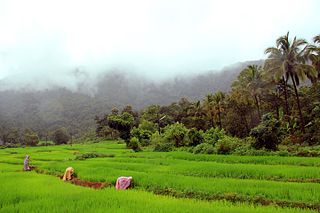
Netravali Wildlife Sanctuary is located in South-Eastern Goa, India. It constitutes one of the vital corridors of the Western Ghats and covers an area of about 211km2. Netravali or Neturli is an important tributary of River Zuari, which originates in the sanctuary. Forests mostly consist of moist deciduous vegetation interspersed with evergreen and semi-evergreen habitat; there are also two all-season waterfalls in the sanctuary.

The white-bellied treepie is a bird of the crow family endemic to the forests of southern India. They overlap in distribution in some areas with the rufous treepie but are easy to tell apart both from appearance and call.

The little spiderhunter is a species of long-billed nectar-feeding bird in the family Nectariniidae found in the moist forests of South and Southeast Asia. Unlike typical sunbirds, males and females are very similar in plumage. They are usually seen in ones or twos and frequently make a tzeck call. They are most often found near flowering plants where they obtain nectar.
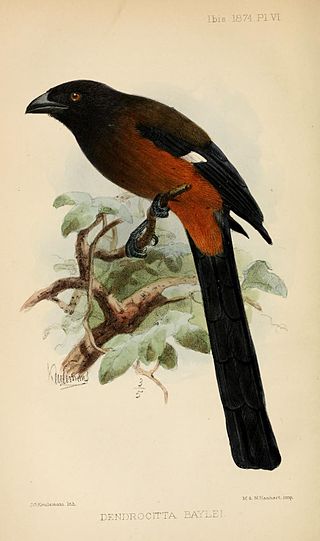
The Andaman treepie is a species of bird in the family Corvidae. First described by Robert Christopher Tytler in 1863, it is endemic to the Andaman Islands of India, where its natural habitat is subtropical or tropical moist lowland forests. It is threatened by habitat loss.
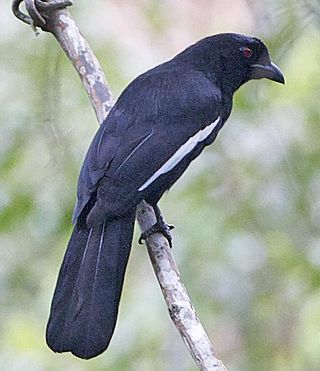
The Malayan black magpie is a species of bird in the family Corvidae. Despite its name, it is neither a magpie nor, as was long believed, a jay, but a treepie. Treepies are a distinct group of corvids externally similar to magpies.

The Bornean treepie is a passerine bird belonging to the treepies genus, Dendrocitta, of in the crow family, Corvidae. It is endemic to the island of Borneo. It is sometimes treated as a subspecies of the Sumatran treepie.

New Amarambalam reserved forest is a reserved forest in the Western Ghats, situated in the Malappuram District of Kerala state of India. It extends till Silent Valley National Park of the Palakkad District to the south and to Nadugani in the Nilgiri District of Tamil Nadu to the North. It is under the Karimpuzha Wildlife Sanctuary.





















